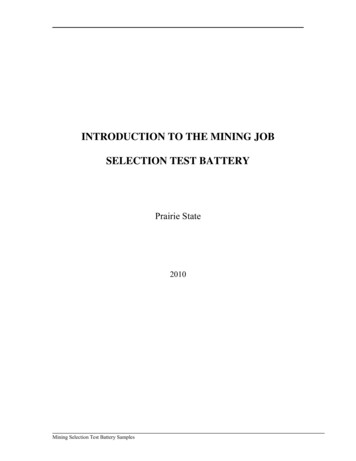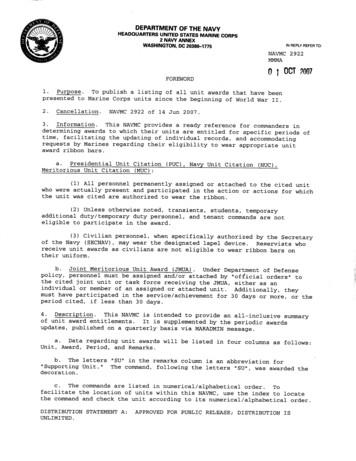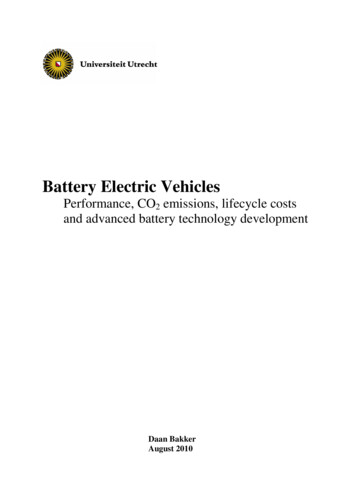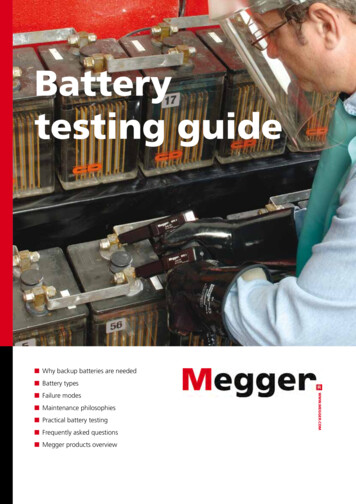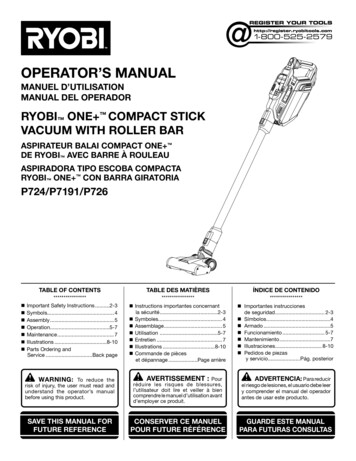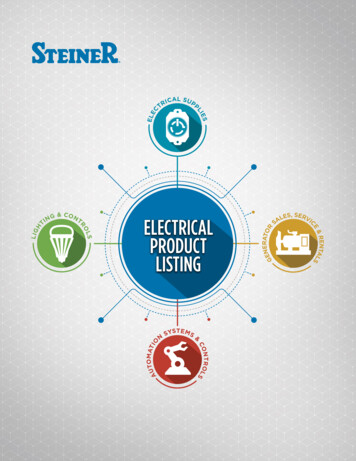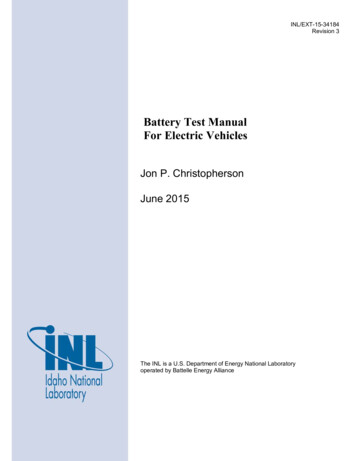
Transcription
INL/EXT-15-34184Revision 3Battery Test ManualFor Electric VehiclesJon P. ChristophersonJune 2015The INL is a U.S. Department of Energy National Laboratoryoperated by Battelle Energy Alliance
INL/EXT-15-34184Revision 3Battery Test ManualFor Electric VehiclesJon P. ChristophersonJune 2015Idaho National LaboratoryIdaho Falls, Idaho 83415http://www.inl.govPrepared for theU.S. Department of EnergyOffice of Energy Efficiency and Renewable EnergyUnder DOE Idaho Operations OfficeContract DE-AC07-05ID14517
INL/EXT-15-34184U.S. Department of EnergyVehicle Technologies ProgramBattery Test ManualFor Electric VehiclesREVISION 3JUNE 2015The Idaho National Laboratory is a U.S. Department of Energy NationalLaboratoryOperated by Battelle Energy Alliance
DisclaimerThis manual was prepared as an account of work sponsored by an agency of the United StatesGovernment. Neither the United States Government nor any agency thereof, nor any of their employees, makesany warranty, express or implied, or assumes any legal liability or responsibility for the accuracy, completeness,or usefulness of any information, apparatus, product, or process disclosed, or represents that its use would notinfringe privately owned rights. References herein to any specific commercial product, process or service bytrade name, trademark, manufacturer, or otherwise does not necessarily constitute or imply its endorsement,recommendation, or favoring by the United States Government or any agency thereof. The views and opinionsof authors expressed herein do not necessarily state or reflect those of the United States Government or anyagency thereof.
Battery Test ManualFor Hybrid Electric VehiclesREVISION 3JUNE 2015Prepared for theU.S. Department of EnergyAssistant Secretary for Energy Efficiency and Renewable Energy (EERE)Idaho Operations OfficeContract DE-AC07-05ID14517
FOREWORDThis battery test procedure manual was prepared for the United States Department of Energy (DOE),Office of Energy Efficiency and Renewable Energy (EERE), Vehicle Technologies Office. It is based ontechnical targets for commercial viability established for energy storage development projects aimed atmeeting system level DOE goals for Electric Vehicles (EVs). The specific procedures defined in thismanual support the performance and life characterization of advanced battery devices under developmentfor EV applications.Due to the complexity of some of the procedures and supporting analysis, future revisions including somemodifications and clarifications of these procedures are expected. As in previous battery and capacitortest manuals, this version of the manual defines testing methods for full-size battery systems, along withprovisions for scaling these tests for modules, cells or other subscale level devices.The DOE-United States Advanced Battery Consortium (USABC), Technical Advisory Committee (TAC)supported the development of the manual. Technical Team points of contact responsible for itsdevelopment and revision are Brian Cunningham (DOE), Chul Bae (Ford Motor Company), Oliver Gross(Fiat Chrysler Automobiles), and Harshad Tataria (General Motors). Jon P. Christophersen from IdahoNational Laboratory was the primary author for the manual.The development of this manual was funded by the Unites States Department of Energy, Office of EnergyEfficiency and Renewable Energy, Vehicle Technologies Office. Technical direction from DOE wasprovided by David Howell, Energy Storage R&D Manager and Hybrid Electric Systems Team Leader.i
ii
CONTENTSFOREWORD . iACRONYMS . viiGLOSSARY . ix1.PURPOSE AND APPLICABILITY .11.1Energy Storage Targets For Electric Vehicles . 12.TEST PROFILES DERIVED FROM TARGETS .33.TEST PROCEDURES .34.3.1General Test Conditions and Scaling . 33.1.1Voltage Limits . 33.1.2Temperature Control . 43.1.3Pressure control. 43.1.4Battery Size Factor. 43.1.5Charging Procedure . 43.2Static Capacity Test . 53.3High Rate Charge . 53.4Hybrid Pulse Power Characterization Test . 63.4.1Hybrid Pulse Power Characterization Test Profile . 63.4.2Test Procedure Description . 73.4.3HPPC Available Energy Verification Test . 93.5Peak Power Test . 103.5.1Peak Power Test Profile. 103.5.2Test Procedure Description . 113.6Self-Discharge Test . 123.7Thermal Performance Test . 133.7.1Survival Temperature Test. 133.8Life Testing . 143.9Cycle Life Dynamic Stress Tests . 163.9.1Cycle Life Test Procedure Outline . 163.9.2Cycle Life Dynamic Stress Test Profile. 183.10Calendar Life Test . 193.10.1Calendar Life Test Planning . 193.10.2Calendar Life Test Procedure . 203.10.3Calendar Life Test Profile. 213.10.4Alternative Calendar Life Test . 223.11Reference Performance Tests. 23ANALYSIS AND REPORTING OF TEST RESULTS .244.1General . 244.2Static Capacity Test . 244.2.1Capacity Fade . 24iii
4.2.25.Energy Fade . 244.3High Rate Charge . 254.4Hybrid Pulse Power Characterization Test . 254.4.1Overall Analysis Approach . 254.4.2Pulse Resistance. 264.4.3Pulse Power Capability . 284.4.4Available Energy and Peak Power. 304.4.5Power and Energy Fade . 314.4.6Other Laboratory Cell Performance Characteristics . 324.5Peak Power Test . 324.5.1Overall Analysis Approach . 324.5.2Pulse Resistance. 334.5.3Pulse Power Capability . 344.5.4Peak Discharge Power . 364.5.5Power and Energy Fade . 374.5.6Other Laboratory Cell Performance Characteristics . 384.6Self-Discharge Test . 384.7Thermal Performance Tests . 384.7.1Survival Temperature Test. 394.8Cycle Life Tests . 394.9Calendar Life Test . 394.10Reference Performance Tests. 404.11Module Controls Verification Tests . 404.12System-Level Testing . 40REFERENCES .41Appendix A - Sample Test Plan.42Appendix B - Gap Analysis Reporting .47Appendix C – Voltage definitions .50iv
FIGURESFigure 1. Hybrid Pulse Power Characterization Test Profile. . 7Figure 2. Hybrid Pulse Power Characterization Test (start of test sequence). . 8Figure 3. Hybrid Pulse Power Characterization Test (complete HPPC sequence). . 9Figure 4. Peak Power Test Profile. . 11Figure 5. Peak Power Test Sequence. . 12Figure 6. Charge-Depleting Cycle Life Test Profile for the EV Battery. . 19Figure 7. Calendar Life Test Profile. . 22Figure 8. Resistance calculation time points. 26Figure 9. Open-circuit voltage and pulse resistances versus capacity removed for HPPC test. . 27Figure 10. Pulse power capability vs %-removed of operating capacity for HPPC test. . 28Figure 11. Relationship Between Energy and %-Capacity Removed in a C/3 Discharge . 29Figure 12. Unscaled HPPC Cell Power Capability vs. Energy Removed. 30Figure 13. Available Energy and Peak Power Determination. . 31Figure 14. Resistance calculation time points for the Peak Power test. . 33Figure 15. Open-circuit voltage and pulse resistances versus capacity removed. . 34Figure 17. Unscaled Peak Power capability vs. energy removed. . 36Figure 18. Available Energy and Peak Power Determination from Peak Power test. . 37Figure B.1. Gap Analysis – HPPC . 47Figure B.2. Gap Analysis – Peak Power . 48Figure C.1. Voltage Definitions and Key Concepts. 50v
TABLESTable 1. Energy Storage System Performance Targets for Electric Vehicles . 2Table 2. Hybrid Pulse Power Characterization Test Profile. 6Table 3. DST Cycle Life Test Profile for the EV Battery. . 18Table 4. Calendar Life Test Profile. . 21Table 5. Reference Performance Tests and Test Intervals for Life Testing. . 23Table B.1. Gap Analysis . 49vi
ACRONYMSBSFBattery Size End-of-LifeEVElectric VehicleFreedomCARFreedom Cooperative Automotive ResearchHPPCHybrid Pulse Power CharacterizationOCVOpen-Circuit VoltagePNGVPartnership for a New Generation of VehiclesRPTReference Performance TestSOCState-of-ChargeUSABCUnited States Advanced Battery Consortiumvii
viii
GLOSSARYAvailable Energy (AE) [Wh] – the single energy point that precisely corresponds to Vminop (i.e., theDOD corresponding to the specified margin from the manufacturer based on rated oroperating capacity) when discharged from Vmaxop at the C/3 rate.Battery Size Factor (BSF) – an integer which is the minimum number of cells or modules expected tobe required to meet all the performance and life targets.Beginning-of-Life (BOL) – the point at which characterization of the test article begins. The BOLHPPC is usually conducted to determine and/or confirm the BSF prior to life testing.C/3 Rate [A]– a current corresponding to the manufacturer’s rated capacity (in ampere-hours) for athree-hour discharge at BOL and 30 C between Vmax100 and Vmin0. For example, if thebattery’s rated capacity is 40Ah, then the C/3 rate is 13.3A. Alternatively, the current can bebased on the operating capacity between Vmaxop and Vmin0.Charge – any condition in which energy is supplied to the device rather than removed from thedevice. Charge includes both recharge and regen conditions. Charge is indicated in thismanual as a negative value (from the perspective of the battery).Default rest [h] – a fixed rest period determined at BOL, it is at least one hour or the time needed toachieve thermal and voltage equilibrium (e.g., rate of change less than 1 C/hour or less than 5mV/h).Depth-of-Discharge (DOD) [%]– the percentage of a device’s operating capacity (Ah) removed bydischarge relative to a fully charged condition, normally referenced to a constant currentdischarge at the C/3 rate.Device – a cell, module, sub-battery or battery pack, depending on the context. The generic term“device” is normally used in test procedures except where a specific type of device is meant.(Most test procedures are intended to apply to any of these types.)Discharge – any condition in which energy is removed from the device rather than supplied to thedevice. Discharge is indicated in this manual as a positive value (from the perspective of thebattery).End-of-Life (EOL) – a condition reached when the device under test is no longer capable of meetingthe targets. This is normally determined from HPPC Test results scaled using the BatterySize Factor, and may not coincide exactly with the inability to perform the life test profile(especially if cycling is done at elevated temperatures).End of Test – a condition where life testing is halted, either because criteria specified in the test planare reached, or because it is not possible to continue testing.Fully Charged – the condition reached by a device when it is subjected to the manufacturer’srecommended recharge algorithm. In this manual, a device is considered “fully charged” atVmaxop, though the manufacturer has the option to make Vmaxop equal to Vmax100.Hybrid Pulse Power Characterization (HPPC) Test – a Reference Performance Test procedure that isused to determine the pulse power and energy capability under no-load conditions as afunction of aging for direct comparison with the targets in a Gap Analysis.Initial Total Energy [Wh] – the single energy point that precisely corresponds to Vmin0 (i.e., fulldischarge) when discharged from Vmaxop at the C/3 rate. This is the energy used to calculatethe Battery Size Factor.Maximum Rated Current (Imax)[A] – the maximum discharge current that a manufacturer will permitto be sustained by a device for 30 seconds or less. (This value need not be achievable overthe full operating range).ix
Operating Capacity [Ah] – the useable capacity at a C/3 rate over the full operating range of thedevice between Vmaxop and Vmin0. The operating capacity should be provided by themanufacturer, or it is established at BOL and remains fixed during life aging.Peak Power Test – a Reference Performance Test procedure that is used to determine the dischargepulse power and energy capability under load conditions as a function of aging for directcomparison with the targets in a Gap Analysis.Power Fade [W] - the change in Peak Discharge Power from RPT0 measured at the DODcorresponding to Vminop to the value determined at some later time, expressed as apercentage of the BOL value. (Similar definitions apply to Capacity Fade and AvailableEnergy Fade, although these are not included in this glossary).Power Margin (W) – for a given Peak Discharge Power, the difference between the calculated peakdischarge power and the corresponding power target for a given application.Profile – a connected sequence of pulses used as the basic ‘building block’ of many test procedures.A test profile normally includes discharge, rest and charge steps in a specific order, and eachstep is normally defined as having a fixed time duration and a particular (fixed) value ofcurrent or power.Rated Capacity [Ah] – the useable capacity at a C/3 rate over the full electrochemical range of thedevice between Vmax100 and Vmin0. The rated capacity should be provided by themanufacturer, or it is established at BOL and remains fixed during life aging.Recharge – a charge interval corresponding to the sustained replenishment of energy by a continuouscurrent or power source (such as an engine-generator or off-board charger).Reference Performance Test (RPT) – periodic interruptions during calendar and cycle life aging togauge degradation in the test article (see Section 3.11). Degradation rates are established bycomparing results from the RPTs during life testing with respect to the initial RPT performedimmediately prior to the start of life testing (usually referred to as RPT0).Regen – a charge interval corresponding to the return of vehicle kinetic energy to a device (typicallyfrom braking). Because of physical limitations, high rates of regen can only persist for a fewseconds at a time. Regen in this manual is indicated as a negative value (from the perspectiveof the battery).Rest – the condition in which energy is neither supplied to the device nor removed from the device.Rest is indicated by zero current.State- of-Charge (SOC) [%] – an estimate of the device charge capability expressed as a percentageof the BOL rated or operating capacity and typically reached by obtaining specified voltages.Voltage limits [V] – numerous voltage limits are defined in the manual as follows:Vmaxpulse [V] – the regen voltage limit; maximum voltage allowed during regen pulses of 10s orless.Vmax100 [V] - manufacturer’s specified voltage and the basis for the rated capacity.Vmaxop [V] – corresponds to the upper end of the intended operating window, as specified by themanufacturer. This is the relevant upper voltage used in all testing unless otherwisespecified and the basis for the operating capacity. This voltage cannot exceed 420 V(scaled) based on the established performance requirements.Vminop [V] – (optional) corresponds to the lower end of the intended operating window. It is avariable parameter that will generally decrease as the test article ages and the minimumvalue is typically specified by the manufacturer.x
Vmin0 [V] – manufacturer’s specified voltage corresponding to the minimum operating voltage(Vmin0). This voltage cannot be less than 220 V (scaled) based on the establishedperformance requirements.Vminpulse [V] – minimum voltage allowed during discharge pulses of 30s or less.VminLow T [V] – the minimum voltage allowable at less than or equal to 0 C set by themanufacturer and the technical program manager.Vnominal [V] – The nominal electrochemical voltage between Vmax100 and Vmin0. It is determinedby the ratio between the total discharge energy and discharge capacity from the staticcapacity test (see Section 3.2).xi
Battery Test ManualFor Electric Vehicles1.PURPOSE AND APPLICABILITYThis manual defines a series of tests to characterize aspects of the performance or life behavior ofbatteries for electric vehicle (EV) applications. Tests are defined based on the Vehicle TechnologiesOffice targets for electric vehicles and it is anticipated that these tests may be generally useful for testingenergy storage devices designed for this purpose. The test procedures in this manual are directlyapplicable to both the complete battery systems as well as cell-level devices. Much of the rationale forthe test procedures and analytical methodologies utilized in this manual evolved from Revision 2 of theUSABC Electric Vehicle Battery Test Procedure Manual (Reference 1), the PNGV Battery Test Manual(Reference 2), the FreedomCAR Battery Test Manual for Power-Assist Hybrid Electric Vehicles(Reference 3) and the Battery Test Manual for Plug-In Hybrid Electric Vehicles (Reference 4).Deviations from the test or analysis procedures defined in this manual must be approved by the USABCtechnical program manager.1.1Energy Storage Targets For Electric VehiclesThe Department of Energy’s Vehicle Technologies Office Energy Storage Targets for EVs are theprimary driving force for the test procedures and methods defined in this manual. The targets are outlinedin Table 1 for a car having an equivalent electric range of 200 miles based on an Urban DynamometerDriving Schedule (UDDS) cycle. Establishing or verifying battery performance in comparison to thesetargets is a principal objective of the test procedures defined in this document. Unless otherwise stated,these targets all pertain to devices operating at 30 C. This manual defines a charge depleting operationalmode, which is intended to allow the vehicle to operate in an all-electric mode (propulsion andaccessories powered by the electric drive and onboard electric energy storage), with a net decrease inbattery state-of-charge (SOC).1
Table 1. Energy Storage System Performance Targets for Electric VehiclesEnd of Life Characteristics at 30 CUnitsSystem LevelCell LevelPeak Discharge Power Density (30 sec)W/L10001500Peak Specific Discharge Power (30 sec)W/kg470700Peak Specific Regen Power (10 sec)W/kg200300Available Energy Density @ C/3 Discharge RateWh/L500750Available Specific Energy @ C/3 Discharge RateWh/ kg235350Available Energy @ C/3 Discharge RatekWh45N/ACalendar LifeYears1515DST Cycle LifeCycles10001000Selling Price @ 100K units /kWh125100Operating Environment C-30 to 52-30 to 52Normal Recharge TimeHours 7 Hours, J1772 7 Hours, J1772Minutes80% DSOC in 15 min80% DSOC in 15 minMaximum Operating VoltageV420N/AMinimum Operating VoltageV220N/APeak Current (30 sec)AUnassisted Operating at Low Temperature%Survival Temperature Range, 24 hr C400 70% AvailableEnergy @ C/3Discharge rate at-20 C-40 to 66400 70% AvailableEnergy @ C/3Discharge rate at-20 C-40 to 66%/month 1 1High Rate ChargeMaximum Self-DischargeNOTESi. Values correspond to End-of-Life (EOL).ii. The targets correspond to commercialization goals in FY 2020.iii. Normal Recharge Time assumes a Level 2 charging based on J1772-2009 standards. No test is defined in this manualfor this target and manufacturers can specify their own charging algorithm provided that it is consistent with thisstandard.iv. The High Rate Charge is based on a 3.2C rate and allows for a 20% SOC margin in energy.v. Note that the targets listed in the open RFPI released on October 2014 used “Useable Energy,” but the terminology hasbeen changed to “Available Energy” to remain consistent with other USABC test manuals.vi. For the Unassisted Operating at Low Temperature target, 70% Available energy refers to 31.5 kWh at the C/3discharge rate for the system level.2
2.TEST PROFILES DERIVED FROM TARGETSThe test procedures described in this manual are intended for use over a broad range of devices at variousstages of developmental maturity. The approach taken for these procedures is to define a small set of testprofiles based on the overall vehicle characteristics, independent of the size or capability of the device tobe tested. These test profiles are specified in terms of the characteristics of vehicle power demand. Theycan be used in various combinations, with the appropriate scaling factors, to define specific performance,calendar or cycle life tests for cells, modules or battery systems.3.3.1TEST PROCEDURESGeneral Test Conditions and ScalingIn general, testing is divided into three broad phases, i.e., characterization, life, and reference performancetesting. Characterization testing establishes the baseline performance and includes static capacity, hybridpulse power characterization (HPPC), peak power, self-discharge, and thermal performance tests. 1 Lifetesting establishes behavior over time at various temperatures, states of charge and other stress conditionsand includes both cycle life and calendar life testing. Reference Performance Tests establish changes inthe baseline performance and are performed periodically during life testing, as well as at the start- andend-of-life testing. A generic test plan for testing is outlined in Appendix A; this outline can be used as astarting point for device-specific test plans.3.1.1 Voltage LimitsSeveral voltage limits are defined in this manual for the purposes of testing and analysis (see AppendixC). The electrochemical voltage range between 100% SOC and 0% SOC are referred to as Vmax100 andVmin0, respectively. Vnominal is the nominal electrochemical voltage between Vmax100 and Vmin0 (i.e.,total energy divided by capacity). For example, if the total discharge capacity (rated) is 2 Ah anddischarge energy is 7 Wh from the initial static capacity test, then Vnominal (Wh / Ah) 3.5V. Sinceenergy storage devices in EV applications may not operate at 100% SOC, the test protocols defined in thismanual also assume a maximum operating voltage, Vmaxop which corresponds to the upper end of theintended operating window. Note that in many cases for EV applications, Vmaxop can equal Vmax100.For the purposes of this manual, a “fully charged device” is when the device has been charged to Vmaxopusing the manufacturer’s recommended procedure, unless otherwise specified. All tests should beconducted within the operating window between Vmaxop and Vmin0. Note that if Vmaxop is not the sameas Vmax100, the manufacturer should also supply the operating capacity of the device (i.e., definedbetween Vmaxop and Vmin0) in addition to the rated capacity (i.e., defined between Vmax100 and Vmin0).As with the rated capacity, the operating capacity is defined during the initial characterizations te
INL/EXT-15-34184 Revision 3 Battery Test Manual For Electric Vehicles Jon P. Christopherson June 2015 Idaho National Laboratory Idaho Falls, Idaho 83415




